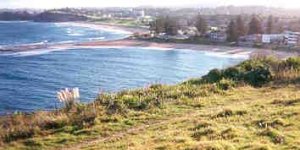New South Wales > Northern Beaches
Mona Vale

| Type | Coastal Cliff with grass slope above. Narrow chute launch between low trees on cliff edge. |
| Conditions | South to South East. Flight characteristics change with slight wind direction variation. Best in S-SSE. Do not launch in SSW due to rotor from upwind headlands and beachside trees. |
| Height | 66' / 20m |
| Rating | PG4 (not recommended for HG) |
North of Mona Vale Beach. Driving south on Barrenjoey Road, turn left into Grandview Parade. Coming from the south turn right at the Bassett St lights and then join Grandview Pde via Orana St. Street parking at the end of Grandview Pde. Do not park in turnaround.
Landowners
Public land
Contact
SPHGC Safety Officers , Sydney Paragliding & Hang Gliding ClubResponsible
Sydney Paragliding & Hang Gliding ClubDescription
This is a small technical but fun site with limited air space and affected by compression. In light conditions there is airspace for only two wings and not many more in stronger conditions. Vegetation growth over recent years has introduced rotor in the launch and top landing zones and care must be taken to line up with the narrow chute during launch and top landing. The cliff edge faces S at the western end and bends more toward the south east at the seaward end. Care should be taken when flying the extremities of the cliff to avoid horizontal compression and penetration issues. As wind goes more SE launch and landing conditions can be tricky. Contact a Club Safety Officer before flying this site for the first time.
The launch spot is on the lower part of the North Mona Vale headland Reserve and is accessible by short walk along a pathway from the end of Grandview Pde. Do not try and launch from the upper part of the reserve particularly in strong conditions as the consequences of being blown over the back, over a sheer cliff are not nice. You will end up in the water.
This is a fun site in the right conditions and one of only two sites which are flyable in a southerly. Always assess conditions from the cliff end of the chute as they can be completely different to conditions in the grassed area. Observe the wind in the trees surrounding the grass area to assess wind direction and strength above the tree line. Either end of the soarable ridge will be affected by compression as the wind wraps around the periphery. Be alert to changes in wind direction and being caught out with lack of penetration.
Takeoff
A small chute is maintained by pilots to enable launch but this is still tricky. There are large tufts of native grasses which makes it tougher. Spread your wing behind the pathway and directly in line with the chute. In light conditions move further back to allow the wing to inflate as you walk backwards. In stronger conditions your wing will pull you back as it inflates - be ready for this as the wing rises above the tree top line. Make sure you have your wing under control before launching.
If the wind direction is SE then wing inflation is made harder as the wind through the chute will not be direct. In these conditions laying the wing out to the west of the launch chute will be necessary and working hard to bring the wing above the tree line. Once your wing is inflated you may need to fly sideways through the chute.
If you are not flying by the time you get to the path it is probably not soarable so abort your launch. Pilots need to be confident of their launch ability in tight conditions and their ability to control the wing as they fly through the launch chute. Assess your immediate turn direction based on wind direction and in light conditions remember the beach is to the right.
Landing
Primary landing area is on the Basin beach at the western end of the cliff and this is always a safe option especially in high wind conditions. The beach landing can still be challenging in high wind condition due to a wind funneling behind the beach and through a park reserve. There are no landing options below the cliff.
The top landing zone is the launch area. It is small and surrounded by trees. Final approach needs to be directly aligned with the chute to avoid as much turbulence as possible. Only land on top if experienced and well briefed. Beware that due to compression it is easy to be blown behind the grass area. As you get lower you will be in a more protected zone and may come down quickly and in turbulence. Due to shape of the headland it is suggested that top landing approaches are from the west.
Flight
Lower Level of controlled airspace is at 2500'
Hazards / Comments
Please read all of the above.
Launch can be tricky due to turbulence from surrounding trees and will be different depending on wind direction.
Be careful of getting caught in horizontal compression at either end of the ridge. Use sound judgement based on wind direction.
Be careful in getting caught in ridge compression as wind becomes stronger. Take the early option to land before you find yourself over the back and in the water.
Top landing can be full of surprises including a quick elevator down as you get low. Only top land if you are experienced at the site.